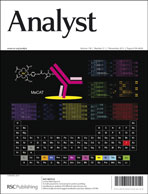An improved electrochemical creatinine detection method via a Jaffe-based procedure†
Abstract
The detection of creatinine via an enzymeless electrochemical method is reported through an indirect electrochemical system in which the picrate anion consumed upon the reaction with creatinine is electrochemically measured. After careful optimisation it is found that in pH 13 two linear analytical ranges are possible utilising an Edge Plane Pyrolytic Graphite (EPPG) electrode: 0–6 mM and 7.5–11.5 mM, with a limit of detection (3σ) corresponding to 0.27 mM; all measurements were taken after a five minute reaction time. Furthermore, screen printed carbon electrodes were applied to the same system and yielded remarkably similar linear ranges to the case of the EPPG electrode: 0–6 mM and 6–11 mM, with a limit of detection (3σ) of 0.72 mM. These results are critically analysed and contrasted with the previous literature. This electrochemical protocol is applied to the detection of urinary creatinine where we find creatinine content of three samples falling well within our reported linear ranges and more importantly indicating correct kidney function. Additionally our electrochemical results are ‘benchmarked’ against UV/Vis spectrometry. The devised electroanalytical protocols have the potential to serve as a more solid foundation for electrochemical creatinine testing and have potential to be applied as a point-of-care diagnostics system through the use of screen printing technology, especially considering urinary creatinine concentrations fall within our reported linear ranges for both healthy adults and adults with deficient glomerular filtration.


 Please wait while we load your content...
Please wait while we load your content...